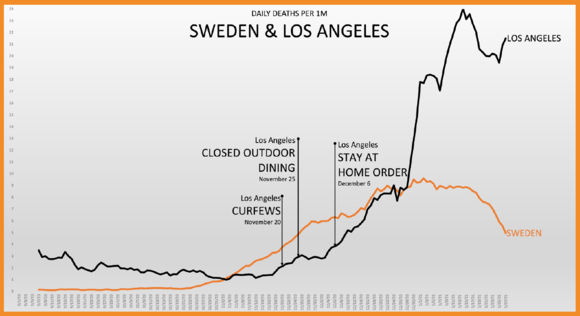|
The data is becoming clearer regarding the effectiveness of lockdowns and other government-imposed responses to the COVID-19 pandemic. Lockdowns are not helping reduce case counts or hospitalizations. Governor Brown’s actions are contributing to the host of negative consequences that result from lockdowns of our society, including, poor and declining mental health; suicide ideation (up 25% in 18-24-year olds); economic ruin for families and small businesses; kids being significantly set back in their education; and many students missing a pivotal part of growing up by not being able to participate in sports and other extracurricular activities.
My office received an email this week from a constituent who explained her son would not be able to compete in his high school track meet, nor take his senior class picture, because he was supposedly ‘exposed’ to COVID though he repeatedly denied being in contact with the original case. In other situations, busloads of kids are being quarantined because they have merely been on the same bus as a positive case, regardless of contact. In more dire circumstances, children have been deprived of the social interaction they need, hot meals, and the teachers and other adults who act as mentors.
My constituents have been drained physically, financially, and morally as a result of the lockdowns. Some have sold everything to make it by because they lost their jobs. Others are just now receiving their Pandemic Unemployment Assistance benefits after more than a year of waiting. This is heartbreaking and unacceptable.
The Oregon Health Authority and Governor Brown say we need to reinstitute lockdowns to prevent hospitals from becoming overwhelmed. That might make sense - if there were evidence that lockdowns worked. The truth is, I am hard-pressed to find a correlation between state management and success in slowing or flattening case rates – and so are researchers. We can see evidence of this failure both here and in other states.
When Florida fully reopened (no state-imposed restrictions, etc.), Dr. Anthony Fauci declared that the state was “asking for trouble.” In early December, Dr. Fauci said that New York had one of the two best responses to the virus. Yet, here is the hospitalization chart, with locked-down California thrown in for good measure:

Researchers have corroborated this trend. In January, Newsweek reported a peer-reviewed study published in the European Journal of Clinical Investigation which analyzed coronavirus case growth in 10 countries in early 2020. “The researchers used a mathematical model to compare countries that did and did not enact more restrictive lockdown orders, and determined that there was ‘no clear, significant beneficial effect of [more restrictive measures] on case growth in any country’.”
Dr. Tom Woods, a senior fellow at the Mises Institute, added to this point when he compared Los Angeles to Sweden:
“The graph that follows may seem a trifle unfair – aren’t Sweden and Los Angeles quite different from each other? Well, sure. But if we were truly facing a catastrophic problem that could be mitigated only by lockdowns, social distancing, and masks, shouldn’t there still be a major difference between relatively laissez-faire Sweden and heavily locked-down Los Angeles? Shouldn’t the difference in results between two places with such different policies absolutely overwhelm whatever other differences exist between them, such that the superiority of the Los Angeles approach should come through clearly in the chart? And yet...”

In Oregon, we are seeing a spike in cases, but not in deaths. Texas is mask-free and 100% open while steadily declining in both new cases and deaths. Other states - Mississippi, Georgia, and Arizona - are loosening their restrictions and declining, or static, in cases as vaccine rollout nears the halfway point.
These points lead us to three conclusions:
- Lockdowns are ineffective at managing case rates.
- People will take voluntary measures to ensure their health and the health of their loved ones.
- Vaccines are effective in reducing deaths among our vulnerable populations.
We are nearing the 50% vaccination mark across the state. Most of our vulnerable populations, if they chose to, have received their shots. It is time to open Oregon. People will make decisions for their safety and the safety of their loved ones. It is not our job to do it for them. The vulnerable are vaccinated. People are ready to get back to living after a year of distress and hardship. It is time to stop the arbitrary-number-guidelines, OSHA at-will fines and permanent rulemaking for a temporary issue. My constituents, and I, have had enough.
Sincerely,
 Vikki Breese-Iverson
State Representative
House District 55
Capitol Phone: 503-986-1455
Capitol Address: 900 Court St NE, H-395, Salem, OR 97301
Email: Rep.VikkiBreeseIverson@oregonlegislature.gov
Website: http://www.oregonlegislature.gov/breese-iverson
|